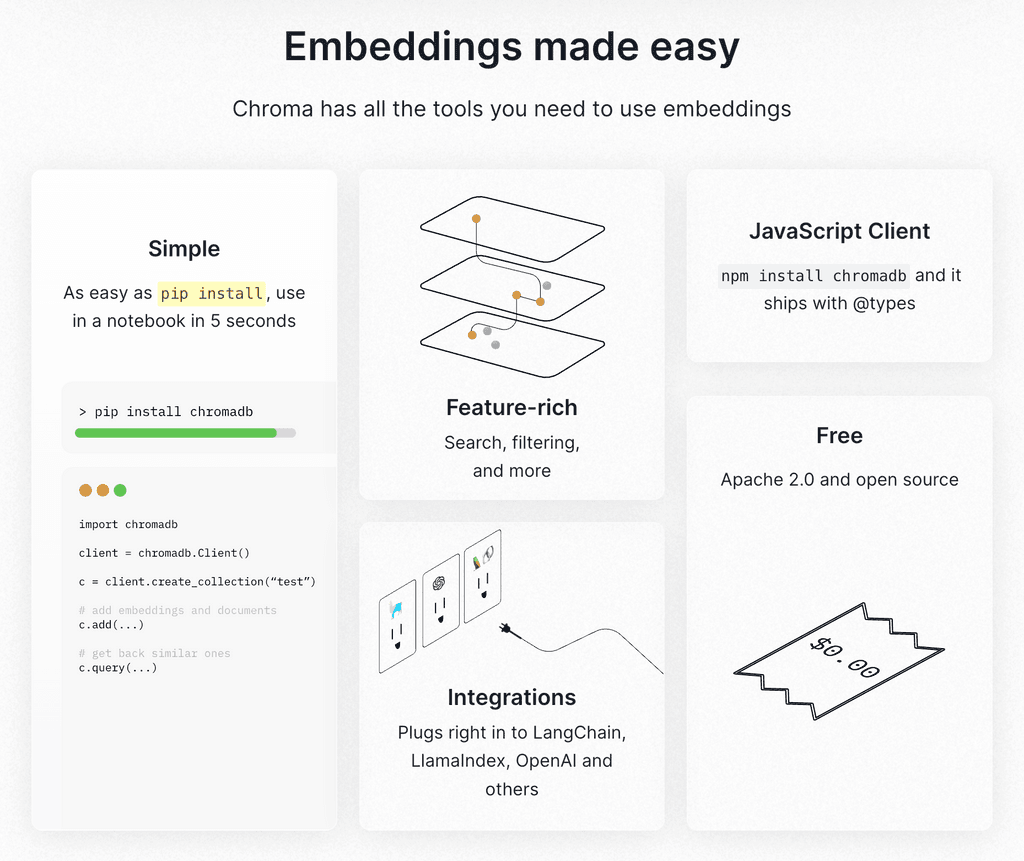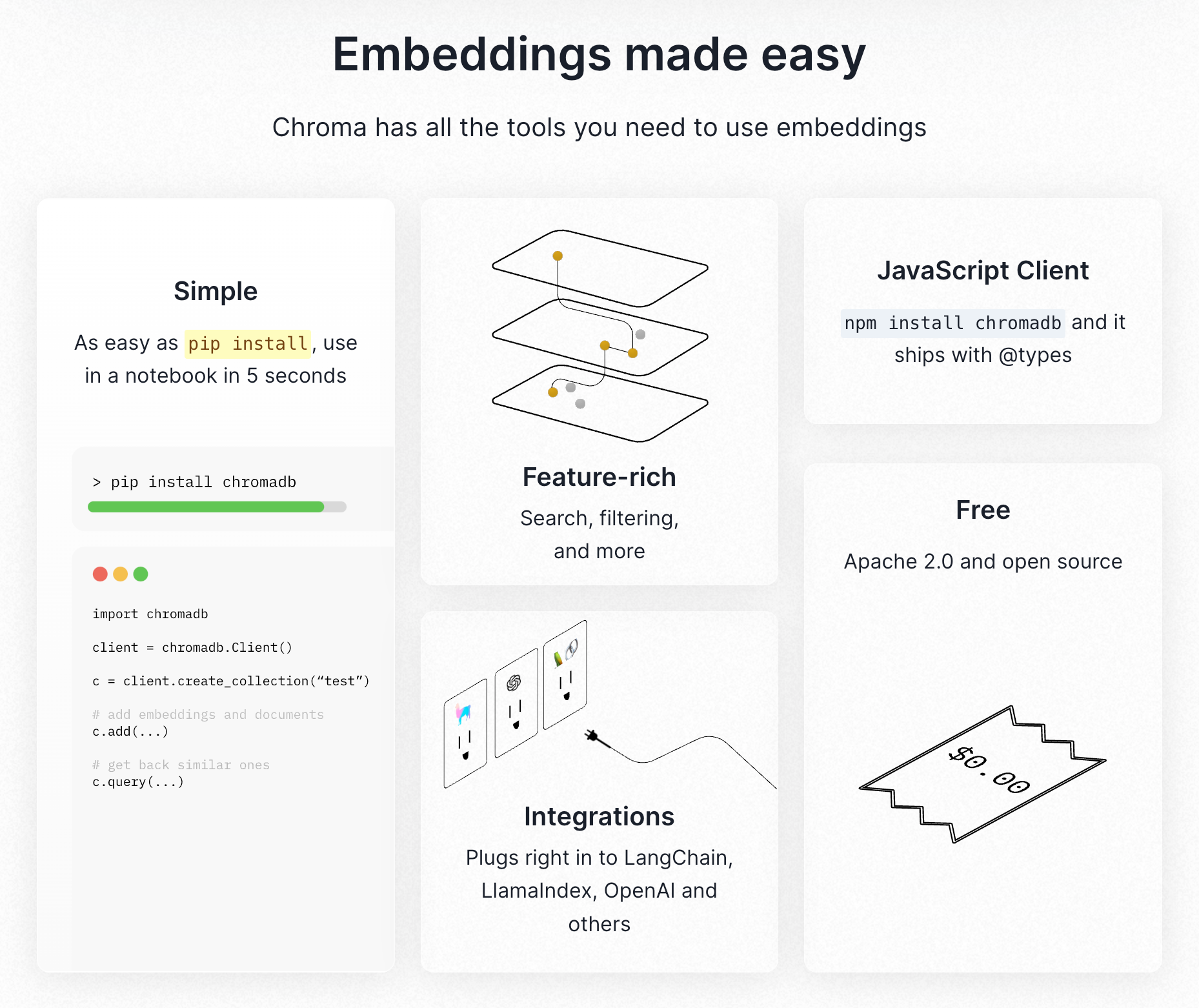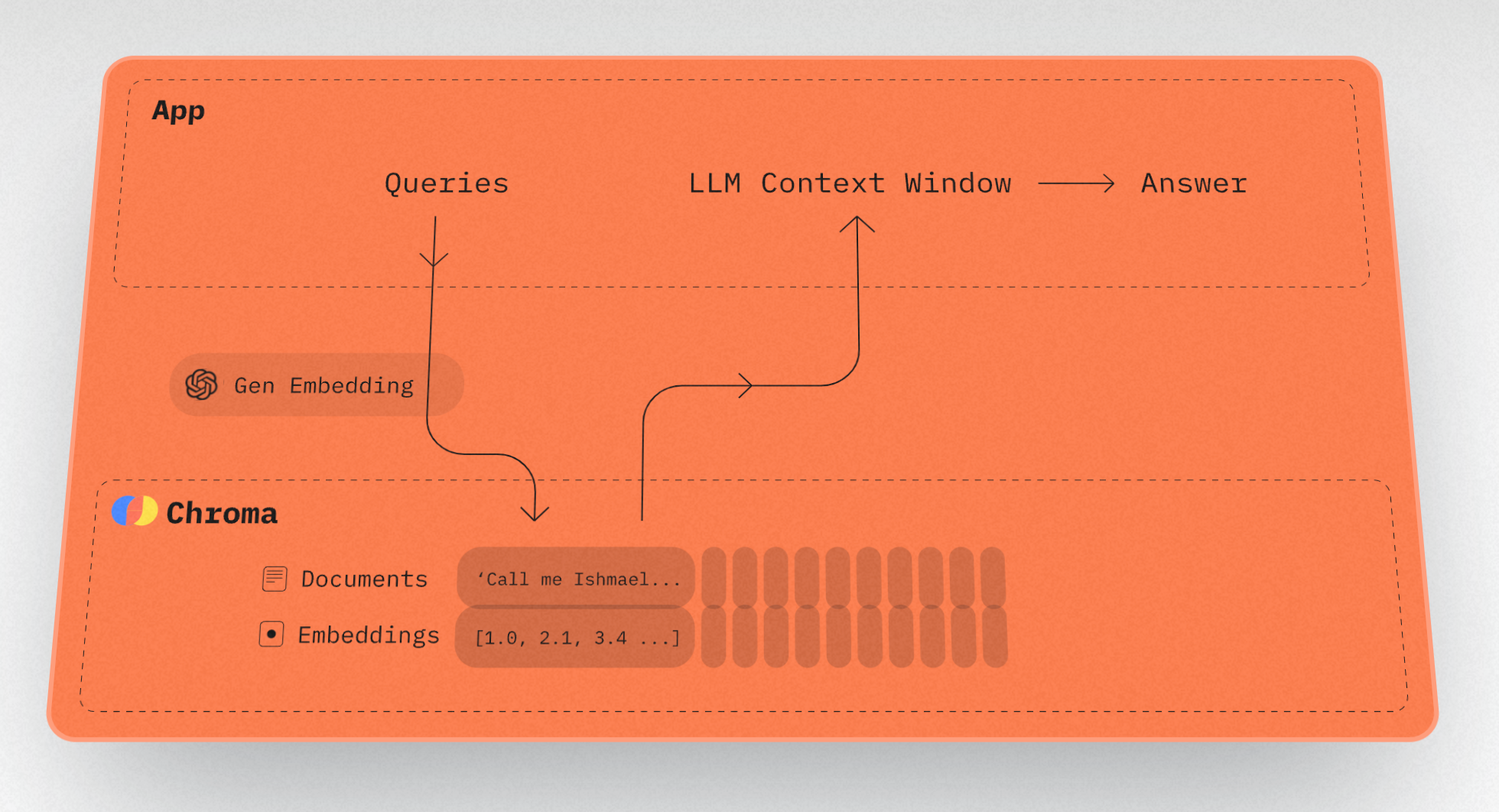Chroma - open-source Vector Database for AI long-term memory and local data — alternative to Pinecone
-
- https://www.trychroma.com
- https://www.trychroma.com/blog/seed
- https://github.com/chroma-core/chroma
- https://twitter.com/trychroma
Chroma - the open-source embedding database.
The fastest way to build Python or JavaScript LLM apps with memory!

What is Chroma?
Chroma is the AI native open-source embeddings database. Using embeddings, Chroma lets developers add state and memory to their AI-enabled applications.Developers use Chroma to give LLMs pluggable knowledge about their data, facts, tools, and prevent hallucinations. Many developers have said they want "ChatGPT but for my data" - and Chroma provides the "for my data" bridge through embedding-based document retrieval.
Chroma comes 'batteries included' with everything developers need to store, embed, and query data with powerful features like filtering built in, with more features like automatic clustering and query relevance coming soon.
It's been amazing to see all the ways that developers have picked up Chroma over the past 5 weeks since launch, crossing 35k python downloads in the past month.
“Chroma’s vector search is as easy as getting started with SQLite - easy to start, open source, scales as you need. For Prefect, I recommend it to our customers for the same reason - they can start flexibly on their own terms as they figure out what they need, and then have the confidence of commercial support down the road.”
Jeremiah Lowin, CEO and cofounder of Prefect, the popular open-source data workflow orchestration software
Why we built Chroma?
Chroma was founded on the principle that models can be understood through interpretability of their latent spaces, and while we were experimenting with that we needed an open-source vector database that was powerful and easy-to-use. We evaluated the existing products, but found they were difficult to use and fundamentally built for a different use case (web scale semantic search). We built Chroma for ourselves, because it was the product we needed and wanted.Anton and I's deep interpretability experience carries through to today; we believe you can’t just hand app developers a ‘vector database’ - you have to support the entire lifecycle from experimentation to scaling.
Why open source?
We are committed to building open source software because we believe in the flourishing of humanity that will be unlocked through the democratization of robust, safe, and aligned AI systems. These tools need to be available to a new developer just starting in ML as well as the organizations that scale ML to millions (and billions) of users. Open source is about expanding the horizon of what’s possible.Baby AGI now uses this:
-
- https://www.trychroma.com
- https://www.trychroma.com/blog/seed
- https://github.com/chroma-core/chroma
- https://twitter.com/trychroma
Chroma - the open-source embedding database.
The fastest way to build Python or JavaScript LLM apps with memory!

What is Chroma?
Chroma is the AI native open-source embeddings database. Using embeddings, Chroma lets developers add state and memory to their AI-enabled applications.Developers use Chroma to give LLMs pluggable knowledge about their data, facts, tools, and prevent hallucinations. Many developers have said they want "ChatGPT but for my data" - and Chroma provides the "for my data" bridge through embedding-based document retrieval.
Chroma comes 'batteries included' with everything developers need to store, embed, and query data with powerful features like filtering built in, with more features like automatic clustering and query relevance coming soon.
It's been amazing to see all the ways that developers have picked up Chroma over the past 5 weeks since launch, crossing 35k python downloads in the past month.
“Chroma’s vector search is as easy as getting started with SQLite - easy to start, open source, scales as you need. For Prefect, I recommend it to our customers for the same reason - they can start flexibly on their own terms as they figure out what they need, and then have the confidence of commercial support down the road.”
Jeremiah Lowin, CEO and cofounder of Prefect, the popular open-source data workflow orchestration software
Why we built Chroma?
Chroma was founded on the principle that models can be understood through interpretability of their latent spaces, and while we were experimenting with that we needed an open-source vector database that was powerful and easy-to-use. We evaluated the existing products, but found they were difficult to use and fundamentally built for a different use case (web scale semantic search). We built Chroma for ourselves, because it was the product we needed and wanted.Anton and I's deep interpretability experience carries through to today; we believe you can’t just hand app developers a ‘vector database’ - you have to support the entire lifecycle from experimentation to scaling.
Why open source?
We are committed to building open source software because we believe in the flourishing of humanity that will be unlocked through the democratization of robust, safe, and aligned AI systems. These tools need to be available to a new developer just starting in ML as well as the organizations that scale ML to millions (and billions) of users. Open source is about expanding the horizon of what’s possible.Baby AGI now uses this:
@marcusquinn Upvoted with all the power of Elon's Starship!
I hope there is a frenzy of upvoting your suggestions, @marcusquinn!

PS LLM = Large Language Model
-
@marcusquinn Upvoted with all the power of Elon's Starship!
I hope there is a frenzy of upvoting your suggestions, @marcusquinn!

PS LLM = Large Language Model
@LoudLemur I honestly think this AI event horizon is going to single-handedly give us another 20 year tech boom. So much of technology is inaccessible, inefficient and full of technical debt, this bypasses all the excuses and shit apps that the world has come to rely on and will help refactor the entire stack that our modern world is built on.
Think, all of this was invented with the upstream battle of the cost of education, that cost is going to almost zero. I can see huge upside for Cloudron. There's still some cleanup effort on existing app stability improvements and long-standing wishlist apps, but the best I can do is encourage everyone to use GPT-4 to figure out the app packaging. Many hands and AIs will help progress.
In fact, some of the apps I'm suggesting can even then ingest Cloudron's live documentation, code, and connect to a Cloudron CLI to develop, self-test and debug.
Feels like a new dawn to me.
-
@LoudLemur I honestly think this AI event horizon is going to single-handedly give us another 20 year tech boom. So much of technology is inaccessible, inefficient and full of technical debt, this bypasses all the excuses and shit apps that the world has come to rely on and will help refactor the entire stack that our modern world is built on.
Think, all of this was invented with the upstream battle of the cost of education, that cost is going to almost zero. I can see huge upside for Cloudron. There's still some cleanup effort on existing app stability improvements and long-standing wishlist apps, but the best I can do is encourage everyone to use GPT-4 to figure out the app packaging. Many hands and AIs will help progress.
In fact, some of the apps I'm suggesting can even then ingest Cloudron's live documentation, code, and connect to a Cloudron CLI to develop, self-test and debug.
Feels like a new dawn to me.
@marcusquinn Yes, it is mind blowing. I loved what you said about the AI being able to replace all the tech with more human friendly stuff, Free Software forever!
Cloudron team, I hope you help make this happen. Things would cascade.
-
 M marcusquinn referenced this topic on
M marcusquinn referenced this topic on
-
 M marcusquinn referenced this topic on
M marcusquinn referenced this topic on
-
 M marcusquinn referenced this topic on
M marcusquinn referenced this topic on


